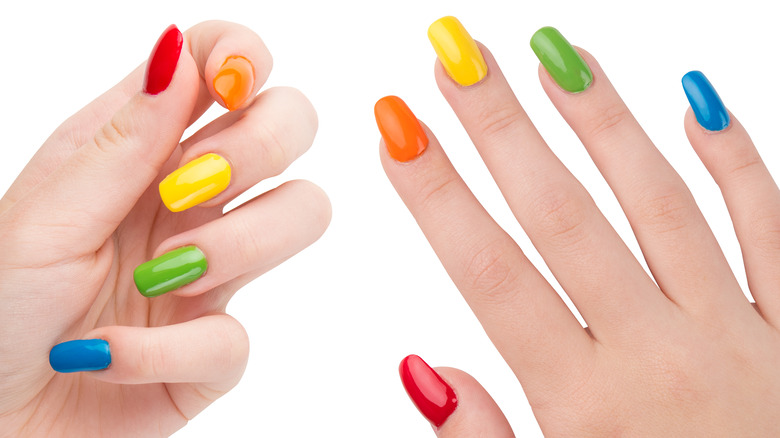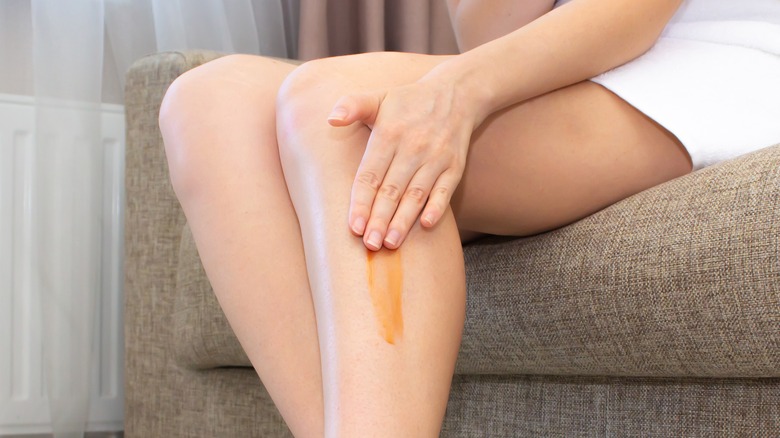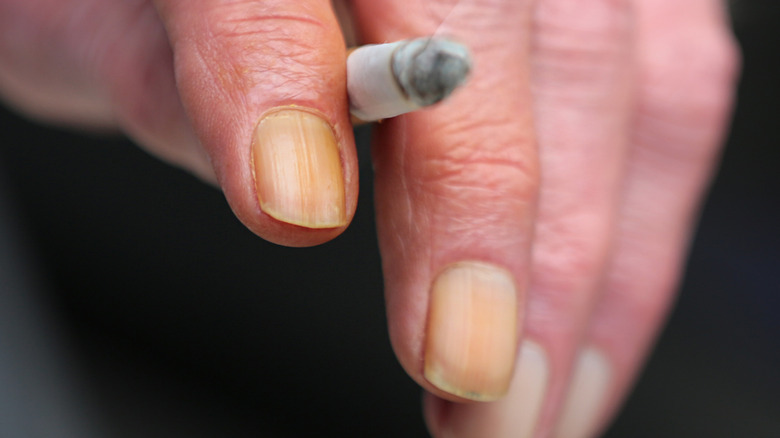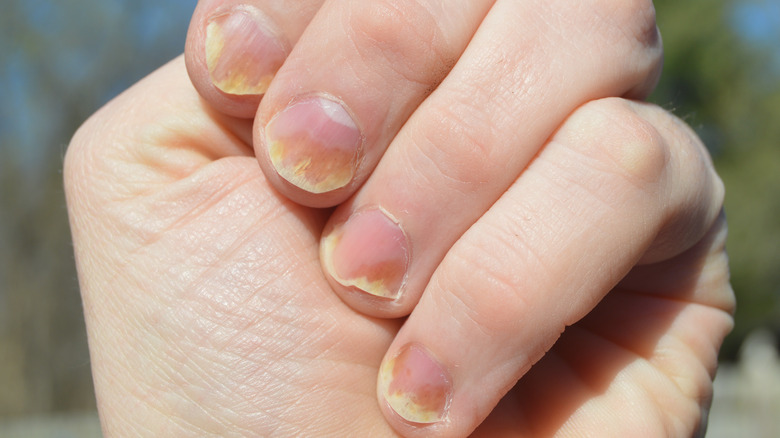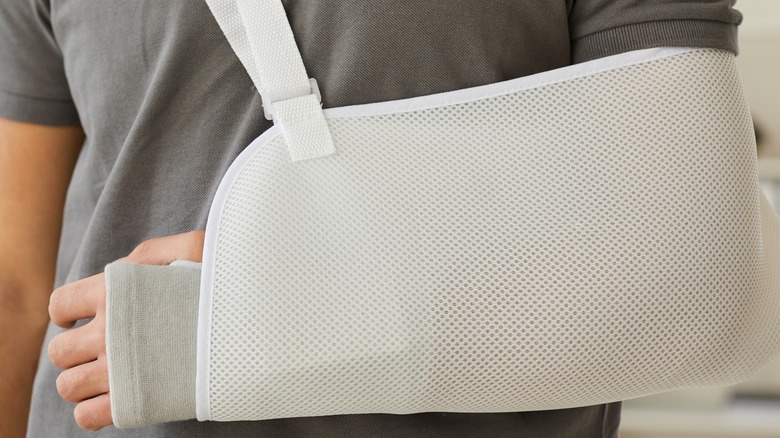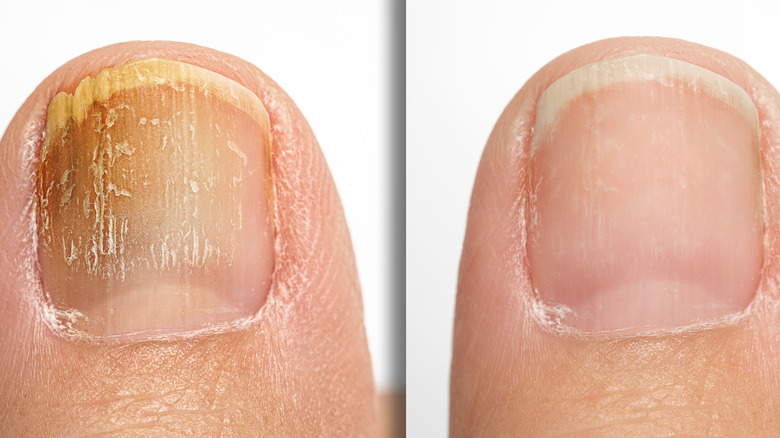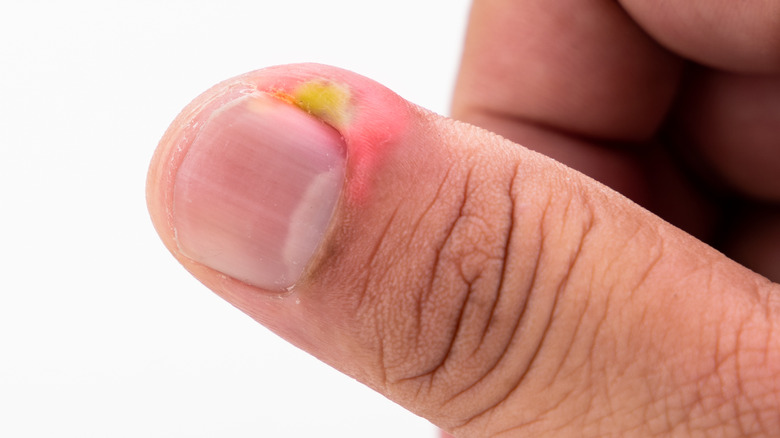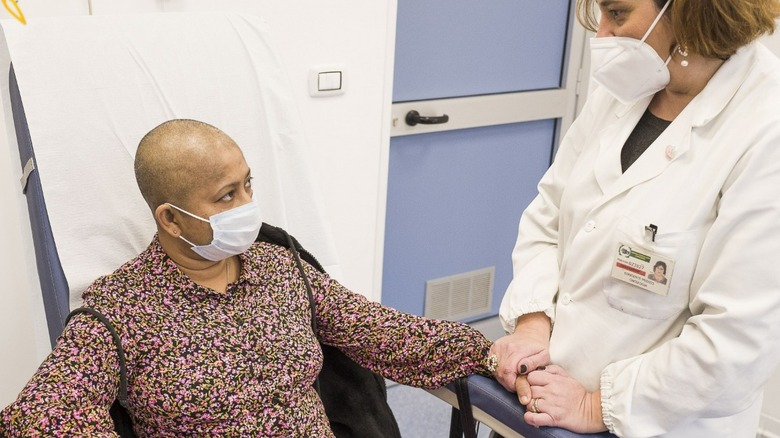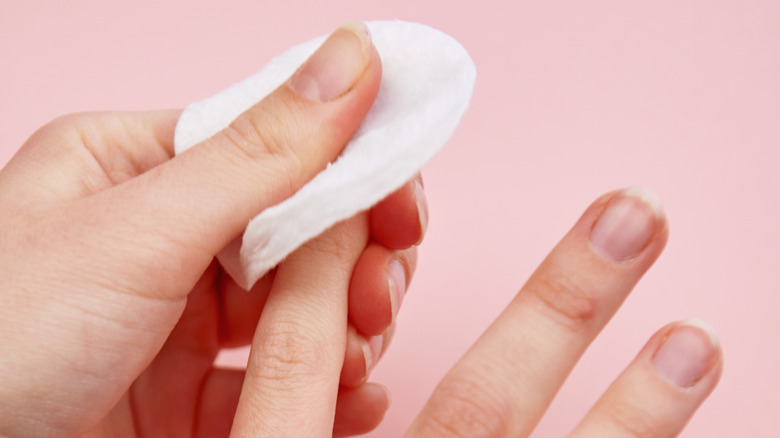The Real Reason Your Fingernails Are Turning Yellow
If you're a weekly manicure kind of person, then you might already be aware, at least on some level, that your fingernails tell a story about you. In fact, they tell many. For example, well-groomed nails convey a sense of composure — one that is relevant enough in the mental health field for therapists to take note of it in patients (per Tufts University). Conversely, bitten nails convey anxiety (via a 1974 study published in the Journal of Clinical Psychology). There are at least a dozen other rather surprising kinds of things your fingernails may be able to tell you about your health that we can think of right off the bat, but the one we're fascinated with at the moment is what it means if your fingernails start looking yellow.
There are a lot of reasons why your fingernails could be turning yellow, and that's not even counting your having decided to paint your nails the color of the sun or some variation thereof. Of course, a number of those reasons are, in fact, purely cosmetic. Others aren't cosmetic but are nevertheless superficial. Still, others involve an injury, infection, or disease process. In all cases, your fingernails have a story to tell you, perhaps one that begins and ends in a nail salon, or maybe one that's a bit more complicated. Let's take a deep dive into the many reasons your fingernails could be turning yellow.
Nail polish is the most common cause of yellow fingernails
If you're just noticing your fingernails are looking yellow and you've recently been wearing a dark nail polish color, there is a pretty decent chance that something in your nail polish is to blame (and if you don't wear nail polish, please do feel free to skip to the next reason your nails might be yellow). According to Self, the pigments in dark-colored nail polish may react with natural compounds found within the nail plate. Alternatively, if your nail polish contains formaldehyde — and many do — the formaldehyde may be reacting with "the keratin protein in your nails," according to dermatologist Dr. Rachel Maiman (via Mind Body Green). In the latter case, in addition to becoming discolored, your fingernails may also become more brittle.
If you're in the habit of picking off your nail polish, then the chances are even better that your choice of nail polish may be to blame for your yellow fingernails, because damaged nails are more likely to yellow when exposed to dark nail polish than healthy nails. According to Charlotte Every, the founding beauty therapist from Team Pamper and The Perfect Pamper, picking off your nail polish – especially gel nail polish — is bad for your nails, and it could take months to grow out the damaged nail (via Insider). On the other hand, even if your nail polish has indeed turned your fingernails yellow, that does not eliminate other possible causes.
Your self-tanner could be staining your fingernails yellow
If you are a reformed sunworshipper, congratulations, because getting too much sun is really bad for you. Unless your skin is olive to light brown or darker, anything more than 10 to 30 minutes of sun exposure may be too much for you (unless you don't mind developing sunburn blisters and other forms of sun poisoning), according to Informed Health. If you are a reformed sunworshipper who has turned to self-tanning at home, congratulations still apply, notwithstanding the fact that sunless tanner does come with some hidden side effects. Sunless tanner can also cause one rather obvious side effect, and that is yellow fingernails.
"There's nothing wrong with a faux-glow, but just like these at-home tanners can cause palms to look yellowish orange, the same goes for your fingernails," says dermatologist Dr. Rachel Maiman (via Mind Body Green). In fact, it's the ingredient that gives your skin a golden suntan-like color that is responsible for causing fingernails that have been exposed to it to turn yellow, according to dermatologist Dr. Joshua Zeichner (via Prevention). We're talking about dihydroxyacetone, which is more commonly known as DHA. Fortunately, you can avoid this result simply by wearing gloves while applying your sunless tanning product. Of course, even if you can accurately pin the blame on having exposed your fingernails to self-tanner, there may be other causes at work as well.
Smoking cigarettes can stain the fingernails yellow
Let's assume, for the moment, that you're a self-tanning goddess with a penchant for having your nails lacquered in Essie's ubiquitous Licorice hue (for the record, it's a shiny opaque black). Obviously, either or both of these factors may be contributing to your yellow fingernails turning yellow. But if you're also a cigarette smoker, then you should probably add your tobacco habit to your list of contributing factors. According to dermatologist Dr. Rachel Maiman, habitual exposure of the fingernails to tobacco smoke can have the effect of staining the fingernails yellowish (via Mind Body Green) — especially the fingers that you use to hold your cigarette.
Like we said, your fingernails tell a story. Another one of the stories your fingernails can tell is that you have finally taken the positive step to quit smoking once and for all. When you stop exposing your fingernails to tobacco smoke, your nail will grow in without the pesky tobacco stains, according to a 1990 paper published in the journal Chest. The study author refers to the telltale pattern seen on recently reformed smokers as the "harlequin nail."
In addition to yellowing of the fingernails, exposing your fingernails to cigarette smoke can cause them to dimple and/or form ridges. But that's not even the worst of it. Smoking is associated with various systemic health problems that are associated with the fingernails growing in yellow, as opposed to merely becoming stained yellow.
Psoriasis can cause your fingernails to turn yellow
Psoriasis is a common and generally minor health condition. It causes inflammation that presents as raised reddish plaques and scales on the skin that can itch, burn, and/or sting, per the National Psoriasis Foundation. Psoriasis is known to be caused by an immune system dysfunction whereby skin cell growth is sped up to the point that the normal process of shedding cannot keep up, leading to a buildup of excess skin cells on the epidermis (the skin's surface). Psoriasis can turn up anywhere on the skin. It can also turn up in the fingernails, according to the American Academy of Dermatology.
Although psoriatic nail disease can vary in how it presents, yellowing nails are a known symptom, as are nails that have a brown or white discoloration, per Dr Jacqueline Payne (via Patient). Other symptoms include dimpling/pitting in the fingernails, crumbling of the fingernails, onycholysis (which is a separation of the nail from the nailbed, per Medical Dictionary), blood or tissue build-up under the nail (per AAD), and a shortening or narrowing of the nailbed (a.k.a. disappearing nail bed).
If your fingernails are turning yellow but you have none of these other symptoms, then psoriasis is less likely to be the reason. However, if you have reason to suspect your yellowing nails may be caused by psoriasis (e.g., a personal history of psoriasis), best practices include checking in with your healthcare provider because available treatments can provide relief/remission (per Patient).
Physical trauma may cause the affected fingernails to appear yellow
Psoriatic nail disease is not the only condition that may cause onycholysis. So too can the presence of a fungal infection and certain medications, according to the Cleveland Clinic. But one of the most common causes of onycholysis is trauma/injury to the nail/nailbed, according to MedScape. Onycholysis itself can cause the nail to appear yellow, according to Dr. Susan Massick (via Ohio State University Wexner Medical Center). However, it's not necessarily because the nail itself has turned yellow. Rather, the space between the nailbed and the nail appears yellow upon having been exposed to the air as a result.
According to Dr. Massick, onycholysis is common among those who engage in manual labor, which makes sense when you consider that working with one's hands increases one's risk of injuring one's hands. The best way to avoid trauma that might cause onycholysis is to take appropriate precautions, such as wearing protective gloves when working with heavy objects and keeping the fingernails trimmed to avoid snagging them on objects that might cause them to tear. If you do find yourself with such a nail injury, Dr. Massick advises against trying to clean under your affected fingernails, as this could exacerbate the damage and delay healing.
A fungal infection can cause yellowing of your affected fingernails
Another story your yellowing fingernails may be trying to tell you is that you've contracted a localized fungus. According to the CDC, the clinical diagnosis is known as onychomycosis. Although onchomycosis can cause the nails to look yellow — or brown, or white, or all of the above — if onchomycosis is indeed causing your nail discoloration, then you'll probably be experiencing other symptoms as well. To wit, your nails may also be thickened. At the same time, they may be fragile and crack easily, just like your skin when you have athlete's foot. In fact, if you have a case of athlete's foot (which usually, but does not always, present between the toes), that could explain where your fingernail fungus came from. You may also experience onycholysis (via the Cleveland Clinic).
Although anyone can contract onchomycosis, it is more common in people who have a case of athlete's foot. It's also more common in people with diabetes and people with circulatory issues, not to mention anyone with a compromised immune system. Finally, it can occur after a nail injury or nail surgery. That's because either one stands to leave the nailbed vulnerable to contamination. If you think that onchomycosis is the reason why your fingernails look yellow, it's worth checking in with your healthcare provider. The CDC notes that this condition can be annoyingly intractable, with the best option usually being prescription anti-fungal pills.
A bacterial infection could cause your fingernails to appear to be yellow
Bacterial infections of the nail, which clinicians refer to as paronychia, may also cause your fingernails or the skin around them to appear yellow. This may occur for either or both of the following two reasons. The first is that bacterial infections tend to produce pus, which can be yellow in color, and paronychia tends to present with a collection of pus, whether under or adjacent to the affected fingernail. That can make the fingernail appear yellow. Other symptoms of paronychia include inflammation of the skin surrounding the nail, which might present as swelling, pain, tenderness, redness and heat.
If left untreated, paronychia may cause the fingernail to begin to detach from the nail bed (onycholysis), per MedScape. In onycholysis, the fingernail that is in the process of detaching may appear yellow as the nailbed becomes exposed to the air (via the Ohio State University Wexner Medical Center). The bacteria most often associated with paronychia are staph (Staphylococcus aureus) and strep (Streptococcus pyogenes), which are no fun, to say the least. However, both are treatable with antibiotics (taken by mouth). In addition, you may need to have the pus drained (it's an in-office procedure). Accordingly, checking in with your healthcare provider if you suspect a paronychia would be prudent.
What is Yellow Nail Syndrome?
On exceedingly rare occasions, yellowing fingernails may be a harbinger of yellow nail syndrome. Yellow nail syndrome, which was first mentioned in medical literature in 1964, is made up of three underlying conditions, all seemingly (but not really) unrelated. The first is yellow nails that have ceased to grow but have nevertheless become thickened and abnormally curved, according to the National Organization for Rare Disorders (NORD). The second is a buildup of excess fluid anywhere in the body in which it does not belong (i.e., lymphedema). One or both of these conditions will usually present first, according to a 1972 paper published in the academic journal Chest.
The third underlying condition is a clinically significant abnormality or disease process in the lungs. That could present as anything from sinusitis to a chronic cough to chronic bronchial abnormalities (i.e., bronchiectasis) to pleural effusion (which refers to fluid buildup in the lungs). Lung complications usually present several months to many years after the onset of the yellowing/thickening/curving of the fingernails and lymphedema.
As noted above, yellow nail syndrome is rare, and it primarily effects adults over the age of 50. Why these three conditions occur together is not well understood, but there may be a genetic component, per NORD. In addition, yellow nail syndrome may be correlated with a higher risk of cancer, especially in the lungs.
Yellow fingernails may suggest the presence of an underlying condition
Most of the time, if your fingernails appear to be turning yellow, there's a simple and generally harmless explanation. Nevertheless, there are instances in which another condition or disease process may be causing the nails to grow in yellow (as opposed to merely becoming stained on the surface). For example, yellow nail syndrome has been associated with Guillain-Barré Syndrome, endometrial cancer, Hodgkin's lymphoma, non-Hodgkin's lymphoma, melanoma, and breast cancer, according to a 2011 study published in the Journal of Clinical Oncology. While lung cancer may also trigger yellow nail syndrome, it has been clinically observed to do so in only very few cases. The first was described in 1987; the next, not until more than two decades later.
In the absence of the triad of symptoms/conditions required by yellow nail syndrome, yellow nails may also suggest a number of other underlying illnesses and conditions. These include hypothyroidism, diabetes, liver disease (as well as other illnesses and conditions that may cause jaundice, whether in the nails, eyes, or skin, melanoma-type skin cancer, rheumatoid arthritis, and even COVID-19. But we advise against diagnosing yourself with any of these illness or conditions without checking in with your doctor, especially because the way that the fingernails present — in addition to appearing yellow — may vary depending on the illness/condition. And in many (if not all) cases, the presence of yellow fingernails alone is generally not dispositive.
Some medications may cause the fingernails to yellow
Certain medications have been known to cause nails to yellow. One of the more common medications that could have this side effect is the antibiotic doxycycline, according to a 2005 case study published in the Pediatric Infectious Diseases Journal. According to the study authors, doxycycline is in the family of drugs known as tetracyclines, which are well known for causing discoloration in the teeth, but this was a rare instance in which the discoloration occurred in the fingernails. In a 2003 case study, doxycycline was found to cause onycholysis in a patient who was using the medication to control acne — another rare instance, according to these study authors.
Less commonly prescribed but much more likely to cause yellow nails due to onycholysis is the chemotherapy drug docataxel, which is often referred to by its brand name Taxotere (via a 2007 paper published in the Yonsei Medical Journal). Taxotere is part of the standard protocol for treating a number of different cancers, including cancers of the breast, gastrointestinal tract, head and neck, lung, and prostate, per WebMD. Taxotere belongs to the family of drugs known as taxanes, and while Taxotere may be the most notorious for causing nail changes, all taxanes are associated with nail changes. According to a 2017 study published in the International Journal of Research in Dermatology, platinum-based chemotherapeutic agents also may cause yellowing of the fingernails as a result of onycholysis.
How to remove yellow stains from nails
If your fingernails are stained yellow from nail polish, self-tanner, or cigarette smoke, the only reliable way to get rid of the staining is by waiting for it to grow out. But you may be able to reverse some of the damage in the meantime with the following remedies.
Per SheKnows, these include soaking the fingertips in lemon juice (10 to 15 minutes, once per day), applying a paste made of one part hydrogen peroxide and two parts baking soda or one part hydrogen peroxide and three parts water and leaving it on for three minutes before rinsing, and scrubbing the nails with a nail brush moistened with whitening toothpaste. If your nails are yellow due to fungal infection, you might try swabbing the nails with a tea tree oil suspension (a few drops of tea tree oil mixed with an ounce of a carrier oil such as olive or coconut), per Healthline. This may also help treat the infection itself, according to a 2013 study published in Mycopathologia. Soaking fingernails in a mixture of hot water and baking soda may have a similar effect. So too can an oregano oil suspension (via a study published in Advances in Experimental Medicine and Biology).
With regard to yellow nail syndrome, a 2006 study published in Pediatric Dermatology suggested that topical vitamin E oil may improve fingernail appearance, albeit not to the level of statistical significance when compared with a placebo oil.


